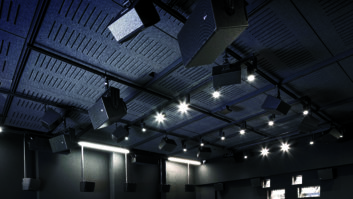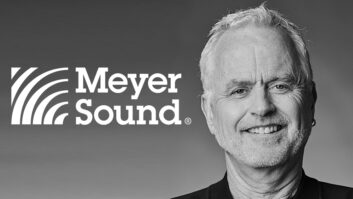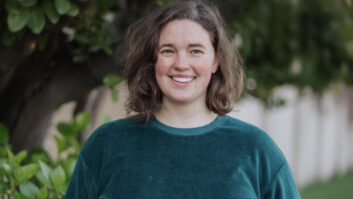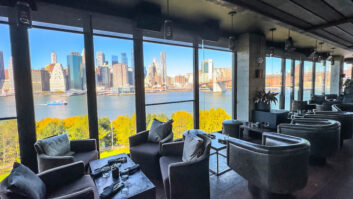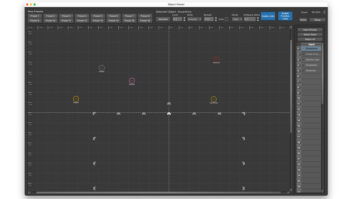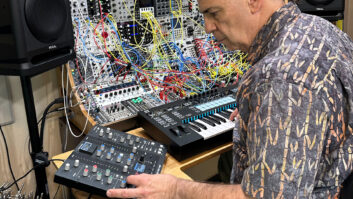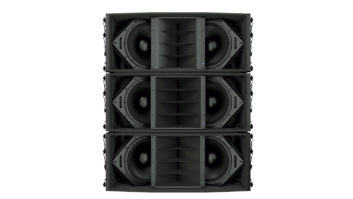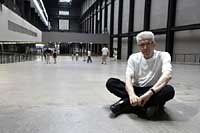
Perhaps because he lives in San Francisco, sound sculptor Bill Fontana (pictured) has come to regard suspension bridges as living structures that should be heard and seen. Fontana creates works in which he puts microphones and sensors in interesting locations and transmits the sounds they pick up to equally interesting locations some distance away, where they are reproduced in real time by carefully placed loudspeakers. Fontana’s recent work, “Speeds of Time,” involved positioning microphones and accelerometers (vibration sensors) in the clockworks of London’s Big Ben and playing the sound back from loudspeakers in a corridor of the Palace of Westminster below. “Sound Island” used hydrophones (underwater microphones) to gather sounds at the beach in Normandy, France, which were reproduced from speakers hung on the Arc de Triomphe in Paris.
His latest creation, “Harmonic Bridge,” taps into the multifarious resonances surging through the Millennium Bridge across the Thames River in London. Sounds that, at most, stay at the edge of people’s consciousness are captured by accelerometers attached to the suspension cables, dynamically mixed by a programmable DSP device, then reproduced to stunning effect in two nearby public spaces: the vast Turbine Hall of the Tate Modern art museum and the nearby Southwark Station of the London Underground.
Fontana has come to rely on Meyer Sound loudspeakers for his endeavors; in fact, Meyer Sound’s MM-4 miniature wide-range loudspeaker was created to meet Fontana’s requirements for a work celebrating a new tramway in Lyon, France.
On prior visits to London, Fontana had become intrigued with the prospect of tapping into the hidden sounds of the newest “stringed instrument” over the Thames. Opened in 2001, the slender 1,050-foot Millennium Bridge is a pedestrian walkway connecting the domed splendor of St. Paul’s Cathedral with the angular bulwark of the former power station that is now the Tate Modern.
With assistance from global consulting and design firm Arup, who built the bridge, Fontana made some preliminary recordings of the bridge and then arranged a demonstration using an acoustic simulation of the Turbine Hall. Ben Borthwick, an assistant curator at the Tate Modern, was enthused by the proposal, although contractual restrictions prevented the museum from commissioning the work internally. At that point, the London Underground’s Platform for Art program stepped forward to assume primary responsibility for organizing and administering the project. “The people with ‘Platform for Art’ were the key in facilitating ‘Harmonic Bridge,’” says Fontana. “It would not have happened without their involvement.”
Engineers from Arup supervised the attachment of accelerometers that would remain in place throughout the exhibition. Resembling spark plugs, these devices make live transmissions of eight discrete sounds to the Tate Modern and also—after downmixing from 8-channel surround to stereo—to Southwark Station via a dedicated digital telephone connection.
Inside the Tate Modern, sound installation and system calibration were entrusted to Autograph Sound Recording in London. To reproduce the full-range sounds of the bridge, Autograph engineers Lee Dennison and Scott George selected an octet of legacy Meyer Sound MSL-2A high-power loudspeakers. “We chose the MSL-2As for this project because of the varying dynamic range of the source signal and the sheer volume of the Turbine Hall,” says George. “The system needed to excite the entire space while still maintaining the subtle nuances of the bridge. Also, the wide angle of dispersion meant the full coverage of the space could be achieved with fewer speaker boxes.”
The MSL-2As are mounted two per side on girders and handrails above a rectangular space delineated by the west entrance of the building and a footbridge spanning the center of the cavernous structure. (The hall measures a total of 500x75x115 feet [LxWxH].) Visitors enter the work as they descend the ramped floor, slowly immersing themselves in the wash of the constantly changing sounds. A pair of legacy USW-1 subwoofers reproduces the deep bass hums and groans of the bridge.
“The range of sounds you hear is quite remarkable,” observes Borthwick, the Tate Modern’s curator for the work. “Over time, you slowly decode the language of the bridge as you notice how sounds relate to the wind, the foot traffic on the deck and boats passing underneath. Some sounds are like a detuned and unplugged electric guitar, and others like a high-pitched woodblock or, in high winds, a Theremin-like sound as cables oscillate in their guide holes.
“The Meyer system is absolutely phenomenal,” he continues. “What’s particularly remarkable is the fact that, even at relatively low levels, you don’t lose any detail. But when there’s a crescendo, like a speeding bicycle, a gust of wind or somebody kicking a cable, and then a detonating sound comes out of nowhere, you hear it with no distortion whatsoever.”
According to Fontana, “It’s everything I’d hoped for and more. You hear the bridge as a living structure as it responds to joggers, the wind and traffic on the river. The ships are particularly mesmerizing, almost like ghost ships, the sonic equivalents of soft shadows passing under the bridge as they fade away with a decaying hiss from the propellers.”
Fontana enhances the bridge sounds by dynamically moving the source signals among the eight loudspeakers using the programmable digital mixing and matrixing facilities of the Richmond Sound Design AB64 AudioBox. “The show control sequence runs about an hour,” says Fontana. “And even if some cues repeat in that sequence, you won’t hear the same thing because the live sounds of the bridge are always changing.”
Safety and security restrictions precluded adding supplemental loudspeakers at the Southwark tube station, so playback there is through the station’s existing audio system. “It’s more in the background because of the public safety issues,” admits Fontana, “yet it’s still quite present and effective. Certainly, it has drawn many favorable comments, and, I suspect, many more visitors to the Tate Modern.”
For more information, visit Meyer Sound at www.meyersound.com.
